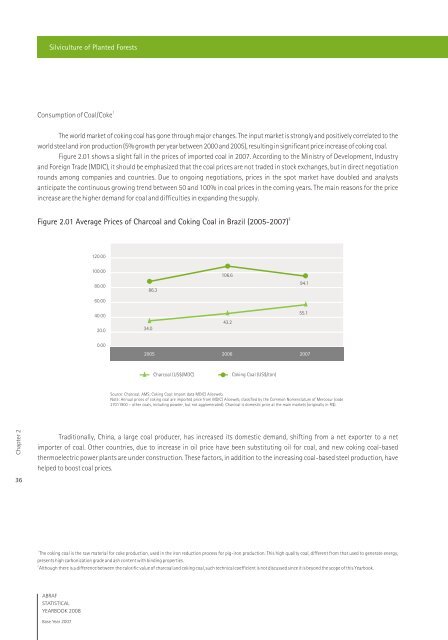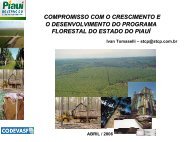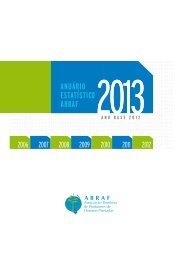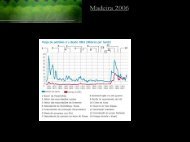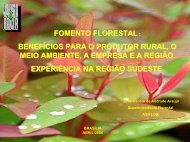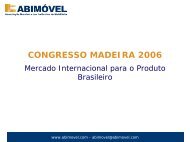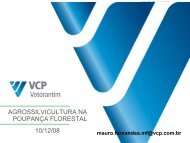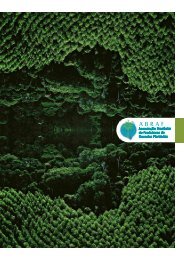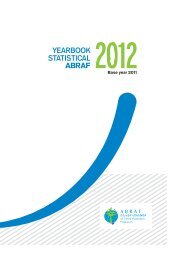innovative concepts based partially or totally on timber supply from partnerships with small and medium-sized in<strong>de</strong>pen<strong>de</strong>ntproducers and small companies. These partnerships aim at fostering forest plantations, particularly in small properties, bysupplying seedling, inputs and technical assistance to producers, guaranteeing future timber purchase. Currently, such schemesoffer higher profits to producers compared to traditional crops and land uses such as cattle, cocoa, corn and some fruit trees.Another aspect that favors this trend is the timber requirement for industrial processing. As they are oriented for shreddingand grinding, non-thinned and non-pruned logs of small-diameter can be used, thus, reducing the forest formation cost.Moreover, the rotation period can be reduced, and with gain in MAI due to high Research and Development (R&D)investments, a larger wood volume is produced per unit area. Such timber can also be produced with lower costs, increasingprofitability, and the attractiveness of the forest business would induce the expansion of planted forest areas and furtherinvestments in industrial projects.2.1.2 Perspectives for Charcoal-Based Iron and Steel Industry in BrazilExpected ExpansionThe Brazilian iron and steel industry is growing. Investments in new industrial plants and the expansion of existing plantswill increase the annual steel production capacity from 33 million to 57 million ton over the next ten years. The NationalDevelopment Bank (BNDES) foresees investments of about R$ 32 billion from 2008 to 2011 in the iron and steel sector. The newplants are expected to use coke as thermal reductor, although only one of the new mills – currently being established with start-upplanned for 2011 – will increase the domestic <strong>de</strong>mand for charcoal from planted forest in nearly 10%.Pig-Iron and Charcoal ProductionThe charcoal-based pig-iron production remained stable over the last three years. The largest pig-iron cluster in Brazil,located in Minas Gerais, has reduced its production. In late 2007, approximately 50% of charcoal-based pig-iron ovens wereinactive. The companies have faced problems to supply charcoal from planted forests, difficulties for railway transportation andloading of pig-iron to export, besi<strong>de</strong>s environmental control. These problems escalated by the appreciation of the Brazilian Real,negatively affecting the competitiveness of the Brazilian product in international markets. This has also been affected by theshrinkage of the US consuming market, the major consumer of pig-iron from Brazil. The export has <strong>de</strong>clined and the domesticconsumption increased. The domestic production was not affected because the production increased in 2007 in the Carajás pigironcluster and in Mato Grosso do Sul.Currently approximately 1/3 of the Brazilian pig-iron production (32.5 million ton in 2006) has been based on charcoal, asthermal reductor, from forest plantations and from natural forests' residues (estimated at 50/50 in 2006). However, due to theincreasing social and environmental pressures against the utilization of wood from natural forest, chiefly initiatives from thepublic and the private sectors came up aiming at substituting wood consumption from natural forests in favor of forest plantationsfor charcoal production.Two outstanding initiatives arise. First, the State Government of Minas Gerais in a public-private partnership aims tostimulate and search for new financing sources to boost forest plantations in the state, from currently 1.2 to 1.8 million hectaresin the next 8 years, representing a 50% growth. This is an answer to the charcoal shortage problem from planted forest and to thenee<strong>de</strong>d preservation of the remaining natural forests. The newly-established Sectoral Chamber for Silviculture un<strong>de</strong>r thecoordination of the State Secretary of Agriculture, Livestock and Supply of Minas Gerais (SEAPA-MG) has discussed this urgentinitiative internally and with the civil society.Second, a private initiative by mining and iron/steel companies of the Northern states, Pará and Maranhão, relies oninvesting and promoting large-scale forest planting in the Carajás mining cluster. This initiative has been led by Vale companythrough the so-called “Vale Florestar Amazonia" project with a budget of USD 200 million up to 2010. It aims to promote theplantation of 150,000 hectares of eucalypt forests in <strong>de</strong>gra<strong>de</strong>d land in the region and to recover 50,000 hectares of natural forests.35<strong>ABRAF</strong><strong>STATISTICAL</strong><strong>YEARBOOK</strong> 2008Base Year 2007
Silviculture of Planted Forests1Consumption of Coal/CokeThe world market of coking coal has gone through major changes. The input market is strongly and positively correlated to theworld steel and iron production (5% growth per year between 2000 and 2005), resulting in significant price increase of coking coal.Figure 2.01 shows a slight fall in the prices of imported coal in 2007. According to the Ministry of Development, Industryand Foreign Tra<strong>de</strong> (MDIC), it should be emphasized that the coal prices are not tra<strong>de</strong>d in stock exchanges, but in direct negotiationrounds among companies and countries. Due to ongoing negotiations, prices in the spot market have doubled and analystsanticipate the continuous growing trend between 50 and 100% in coal prices in the coming years. The main reasons for the priceincrease are the higher <strong>de</strong>mand for coal and difficulties in expanding the supply.2Figure 2.01 Average Prices of Charcoal and Coking Coal in Brazil (2005-2007)120.00100.0080.0086.3106.694.160.0040.0020.034.043.255.10.002005 20062007Charcoal (US$/MDC)Coking Coal (US$/ton)Source: Charcoal; AMS; Coking Coal: Import data MDIC/ Aliceweb.Note: Annual prices of coking coal are imported price from MDIC/ Aliceweb, classified by the Common Nomenclature of Mercosur (co<strong>de</strong>27011900 – other coals, including pow<strong>de</strong>r, but not agglomerated). Charcoal is domestic price at the main markets (originally in R$).Chapter 236Traditionally, China, a large coal producer, has increased its domestic <strong>de</strong>mand, shifting from a net exporter to a netimporter of coal. Other countries, due to increase in oil price have been substituting oil for coal, and new coking coal-basedthermoelectric power plants are un<strong>de</strong>r construction. These factors, in addition to the increasing coal-based steel production, havehelped to boost coal prices.1The coking coal is the raw material for coke production, used in the iron reduction process for pig-iron production. This high quality coal, different from that used to generate energy,presents high carbonization gra<strong>de</strong> and ash content with binding properties.2Although there is a difference between the calorific value of charcoal and coking coal, such technical coefficient is not discussed since it is beyond the scope of this Yearbook.<strong>ABRAF</strong><strong>STATISTICAL</strong><strong>YEARBOOK</strong> 2008Base Year 2007


